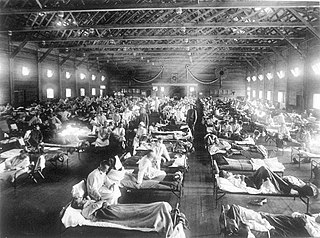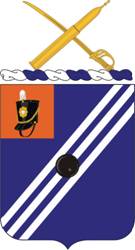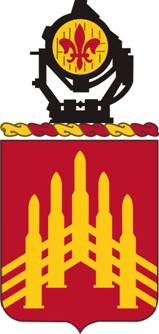
The 5th Infantry Division (Mechanized)—nicknamed the "Red Diamond", or the "Red Devils" —was an infantry division of the United States Army that served in World War I, World War II and the Vietnam War, and with NATO and the U.S. Army III Corps. It was inactivated on 24 November 1992 and reflagged as the 2nd Armored Division.

Fort Devens is a United States Army Reserve military installation in the towns of Ayer and Shirley, in Middlesex County and Harvard in Worcester County in the U.S. state of Massachusetts. Due to extensive environmental contamination it was listed as a superfund site in 1989. Most of the fort's land was sold off in 1996, but the cantonment area of the post was retained by the Army as the Devens Reserve Forces Training Area (RFTA). Fort Devens was reactivated in May 2007, though no units of active Army have been located there. The Devens Range Complex operates on property in Lancaster, south of Route 2, for live-fire training with small arms, machine guns, grenades, and rockets.

Camp Upton was a port of embarkation of the United States Army during World War I. During World War II it was used to intern enemy aliens. It was located in Yaphank, New York in Suffolk County on Long Island, on the present-day location of Brookhaven National Laboratory.

The 77th Sustainment Brigade is a unit of the United States Army that inherited the lineage of the 77th Infantry Division, which served in World War I and World War II. Its headquarters has been at Fort Dix, New Jersey, since its predecessor command, the 77th Regional Readiness Command, was disestablished in 2008 from Fort Totten in Bayside, Queens, New York. Soldiers from the 77th have served in most major conflict and contingency operations since World War II.

The 31st Infantry Division ("Dixie") was an infantry division of the United States Army National Guard, active almost continuously from 1917 to 1968. Composed of men from Alabama, Florida, Georgia, Louisiana, Michigan, Illinois, and Mississippi at various points in its existence, the division saw service in both World War I and World War II, and was mobilized during the Korean War, although it was not sent overseas in the latter.

Camp Funston is a U.S. Army training camp located on Fort Riley, southwest of Manhattan, Kansas. The camp was named for Brigadier General Frederick Funston (1865–1917). It is one of sixteen such camps established at the outbreak of World War I.
The 15th Cavalry Division was a cavalry division of the United States Army during World War I, the only United States cavalry division formed during the war.

The 11th Infantry Brigade is an inactive infantry brigade of the United States Army. It was first formed as part of the 6th Division during World War I. It is best known for its service with the 23rd Infantry Division from 1967 through 1971 in the Vietnam War as a light infantry brigade. The brigade is known for its responsibility in the My Lai Massacre.

The Panama Canal Division was a unit of the United States Army, established in order to ensure the United States could adequately defend the Canal Zone in Panama. When it was authorized in 1920, similar divisions were organized to defend Hawaii and the Philippines.

The 12th Division was an infantry division of the United States Army, active in 1918–1919. Established at Camp Devens, Massachusetts, training was interrupted by the World War I Armistice and the division was quickly afterwards disestablished.

The 39th Infantry Division was an infantry formation of the Army National Guard, originally formed as the 18th Division in 1917. The division consisted of troops from Arkansas, Louisiana, and Mississippi. After training at Camp Beauregard, Louisiana, the division was deployed to France but did not see combat before the end of World War I. In July 1923 the division was re-designated as the 31st Infantry Division. The 39th Infantry Division was reactivated after World War II with troops from Louisiana and Arkansas and its headquarters in Louisiana. In 1967, the 39th Infantry Division was reorganized to become the 39th Infantry Brigade (Separate). Its headquarters was in Little Rock and the unit consisted entirely of troops from Arkansas.

The 76th Field Artillery Regiment is a field artillery regiment of the United States Army. First formed as a cavalry regiment in 1916, the regiment was converted to field artillery in 1917, and served in Europe during World War I with the 3rd Division and as a separate battalion during World War II, as well as in peacetime at Fort Knox, KY, and Fort Devens, MA. Since 1959, the regiment has been a parent regiment under the Combat Arms Regimental System and the U.S. Army Regimental System, with regimental elements serving with the 3rd Infantry Division in Germany and Operation Iraqi Freedom, with the 7th Infantry Division in Korea, and in the Army Reserve. No regimental elements are currently active.

The 71st Air Defense Artillery was a regiment in the United States Army.

The 324th Infantry Regiment was an infantry regiment of the United States Army first organized in August 1917 as part of the 81st Division, National Army. The 324th Infantry saw combat in the defense of the St. Die sector of Lorraine, and later took part in the closing stages of the Meuse-Argonne offensive of the First World War. The 324th Infantry was demobilized in June 1919, and subsequently reconstituted in the Organized Reserves in 1921, as part of the 81st Division. In 1942, the 324th Infantry was relieved from assignment to the 81st Division, allotted to the Army of the United States, and assigned to the 44th Infantry Division, a unit which fought as part of the 7th Army in France and Germany during World War II.
The 162d Depot Brigade was a training and receiving formation of the United States Army during World War I.
The 307th Infantry Regiment was a National Army unit first organized for service in World War I as part of the 77th Division in France. It later served in the Pacific Theater during World War II. Since then it has served as a training Regiment. In 1999, it was withdrawn from the Combat Arms Regimental System and redesignated as a non-branch regiment. The regiment's 1st Battalion is assigned to the 174th Infantry Brigade at Joint Base McGuire–Dix–Lakehurst, New Jersey, with the 2nd Battalion is assigned to the 157th Infantry Brigade at Camp Atterbury, Indiana.
The 90th Infantry Regiment was a Regular Army infantry regiment of the United States Army, which existed during World War I and World War II.
The 305th Infantry Regiment was a National Army unit first organized for service in World War I as part of the 77th Infantry Division in Europe. It later served in the Pacific Theater during World War II. Since then it has served as a training Regiment. In 1999, it was withdrawn from the Combat Arms Regimental System and redesignated as a non-branch regiment. The regiment's 1st and 2nd battalions are stationed at Camp Shelby under the command of the 177th Armored Brigade. The regiment's 3rd battalion is inactive.

John E. Woodward was a career officer in the United States Army. A veteran of the Spanish–American War, Philippine–American War, Moro Rebellion, Pancho Villa Expedition, and World War I, he served from 1892 to 1934 and attained the rank of brigadier general. Woodward was most notable for his command of the 113th Infantry Regiment, Camp Upton, 152d Depot Brigade, 24th Infantry Brigade, 151st Depot Brigade, and 12th Division.














